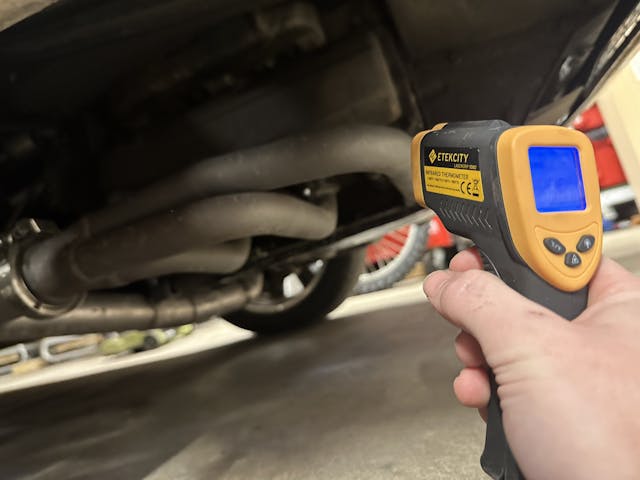6 Diagnostic Tools Every DIY’er Needs
Working on cars and trucks is often a mix of necessity and curiosity. The combination of “this needs to be fixed” and “I bet I can fix this” has gotten more than a few people in over their heads due to swiping credit cards and replacing parts that logic says are faulty even when that’s not the case. The key to good DIY mechanic work is diagnostics: everything else is just parts replacing.
If you want to save time, money, and frustration while getting your cars back on the road safely there are a handful of tools that will help stack the deck in your favor. Make sure these are in your tool box—and you know how to use them—to ensure your next breakdown will only be with the car and not your mind.
Compression Tester

The darkhorse in the four-stroke cycle is the squeeze that comes before lighting off the air and fuel mixed in the chamber. Compressing the air/fuel mixture increases the power potential, but if your engine is unable to properly compress the mixture the engine won’t run properly. Knowing how much squeeze your engine has is a very helpful diagnostic data point as often we don’t have the ability to peek inside an engine easily or without a parts bill that may or may not help the initial problem and could potentially create another.
Leak Down Tester
A compression tester will tell you if you are losing the squeeze, but a leak down tester is more likely to tell you where. Using a compressor rather than piston and crankshaft to provide the pressure in the cylinder, we are able to see exactly how much is escaping and also try and get a feel for where. Use a leak down tester to pressurize the cylinder and listen or feel for leaks from the valves by paying close attention to the intake and exhaust tract. Look for bubbles or changes in coolant level to see if the pressure is escaping the head gasket into the cooling system.
Multimeter
Despite having never met someone who enjoys diagnosing electric gremlins, there are a lot of us who do take the time to suss out why the magical pixies using the copper highways of our wiring harnesses are struggling with a traffic jam or road closure.
Electrical issues often are tough to find but rewarding when solved. Understanding your electrical system and using a shop manual to aid in properly testing various components can save hours and hours worth of headaches and weeks of waiting on parts that may or may not fix the problem at hand. If you find electric work is not terrifying, consider grabbing a power probe for additional diagnostic superpowers.
Vacuum gauge


Leaks on the intake side of the engine can cause all kinds of havoc and strange running conditions. Knowing the vacuum in the intake manifold can tell one a lot in terms of engine health. Ask anyone who has set the ignition timing of an engine by using a vacuum gauge. Spikes or other erratic movements in vacuum on a running engine can point to valves that aren’t sealing properly, intake leaks, and even clogged vacuum passages inside manifolds.
Infrared thermometer

Locating parts that may be hot that shouldn’t be, or vice versa, can be very telling when investigating the condition and health of an engine. I’ve used an instant read thermometer to diagnose lean-running cylinders and clogged passages in a radiator by looking for cool spots in what should normally be evenly warm. Sometimes just touch is enough, and other times a spritz of water might tell you just as much, but having an accurate measurement can be wonderful for comparison and these termometers have only been getting more affordable in recent history.
OBD Scan Tool

Cars are more connected than ever and even if your fun to drive car is not very connected, your daily driver likely is. Scan tools that use the on board diagnostics ports found under the dashboard on most modern vehicles can be a very efficient way to narrow down where to start doing actual diagnostics and inspection since often times these tools talk in codes that can be awfully vague or mixed considering it’s called on board diagnostics. To be fair, every diagnostic tool is only powerful when used and interpreted correctly.



John: in my garage, it it has an OBD connector, it’s banished asap! Give me a car a mortal can work on, not a transportation appliance, any day! Wick in N CA– not enjoying the Park Fire!!!
James,
Have an OBD connector on my 2008 CLK 350 convertible – hardly a transportation appliance. The connector is 37 pins, not the usual smaller pin count. Bought the applicable code reader (second hand, $50, didn’t fit someone else’s MB, normal price about $300). It is a WONDERFUL tool – finds all kinds of obscure issues in a very complex – undoubtedly overly complex – car. Allowed me to fix the A/C for a whopping $12. Allows me to know what’s going on inside the car so I can do preventive maintenance. Allows me to fix stuff without guesswork and without futilely throwing lots of expensive parts at it. Reduces frustration because I can now immediately KNOW where the problem is, take care of it, and go out and enjoy driving the car.
OBD isn’t your enemy, it is just another tool which helps you fix your car. It lets the car tell you what’s wrong, like answering a doctor when they ask you “Where does it hurt?” The more complex cars become – and they’re not going to get any simpler – the more valuable these readers are.
While old cars (pre OBD-anything) are far simpler, they are also far less capable, far less safe, and far less reliable. That’s a hard pill for me to swallow, having owned and worked on dozens and dozens of pre-OBD cars, motorcycles, airplanes, etc. for sixty years (!), but I have to face facts – if I want a modern vehicle, I either get a code reader or pay the stealer to read the codes and fix the car for me. Old cars are great, but tend to mostly get used recreationally, weekend drives, car shows, etc. and don’t put on a lot of miles any more.
The video diagnosing the bad piston rings was the best I have ever seen. Straight forward. picture and words – great teaching. Wish I had that tutoring when I was 18.
Way to make me feel old, I thought for sure that a dwell meter would be on the list. I have one and I still use it for a lot of things.
Yeah, still have one under my bench along with a couple of timing lights!
I worked with a gent that always had a way to find a way to locate a problem. On one occasion, after considerable time and effort trying to find a short in a school bus, my buddy simply hooked the battery charger up to the terminal end of the wire and grounded the charge and wait for smoke somewhere along that 40 feet of tin. It worked, but made a mess!
Voltage drop tests are more telling and less likely to produce false-positive results than those that require your break the circuit by unplugging a cable or pulling a fuse. ATC type fuses have test terminals that make this easy, and there is documentation available from some test equipment manufacturers to calculate current passing through a fuse based on the voltage measured across it.
I have a $30 borescope that links to my phone. I have used it more often than I ever thought I would from car projects to house repairs. Seeing inside cylinders or walls can be invaluable.
I bought a $15 borescope that connects to my phone a few years ago when I dropped a stud inside the tappet case on an old MG. Finally found it lying in between two rod journals on top of the crankshaft! …that was after fishing from the top and the oil drain plug with all kinds of magnets and grabbers and not finding anything.
The one I reach for most often is still my old Test Light
Can’t seem to find the OBD port on my 1967 GTO. Any idea where it might be?
Look in a mirror, you will find it located between the ears!
B^)
all this has so far not mentioned the problem with the newer cars having EVERYTHING going through to a computer, even the head lights are switched by it. To determine what a problem is–you need a BREAKOUT BOX which has a tiny LED for every in or out so you can determine if the message is getting to the box or it isn’t doing what it was asked for.